Strategic Human Resource Management Report for Unilever
VerifiedAdded on 2023/01/04
|15
|5041
|50
Report
AI Summary
This report delves into the realm of Strategic Human Resource Management (SHRM), examining its core principles and practical applications within the context of a case study on Unilever. The report begins by outlining recent trends and developments that influence HR strategies, such as technological advancements, demographic shifts, and globalization. It then explores the internal and external factors, including government regulations, economic conditions, organizational mission, culture, and structure, that shape these strategies. Furthermore, the report applies relevant theories, such as personnel management theory (Theory X and Theory Y) and HRM theory, to enhance workforce growth and development, addressing issues like employee motivation and productivity. A key focus is on change management, with an analysis of Kotter's 8-step model to support HR strategies. The report concludes by discussing methods for monitoring and measuring HR outcomes, including employee development and sustainability, providing a comprehensive overview of SHRM principles and practices.
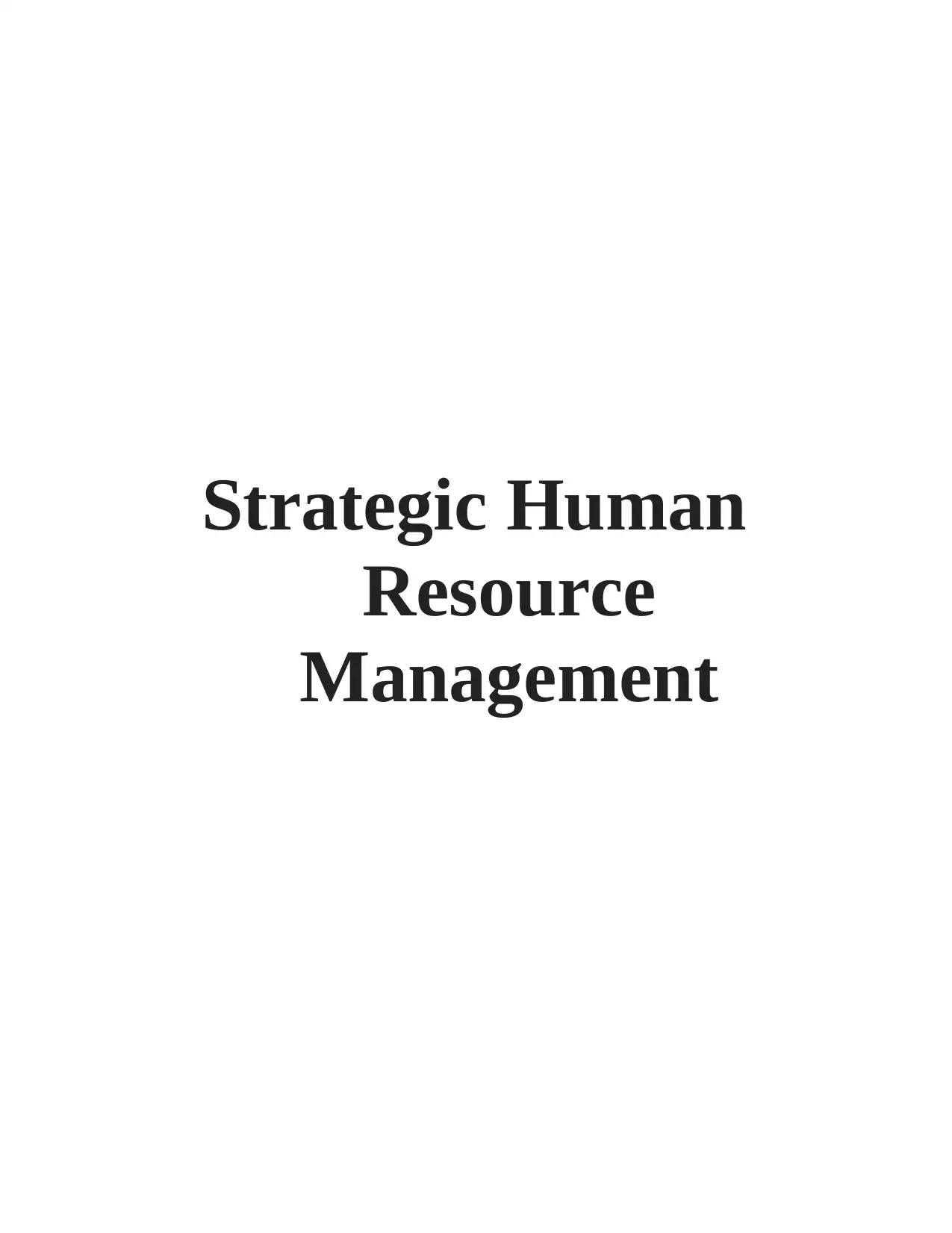
Strategic Human
Resource
Management
Resource
Management
Paraphrase This Document
Need a fresh take? Get an instant paraphrase of this document with our AI Paraphraser
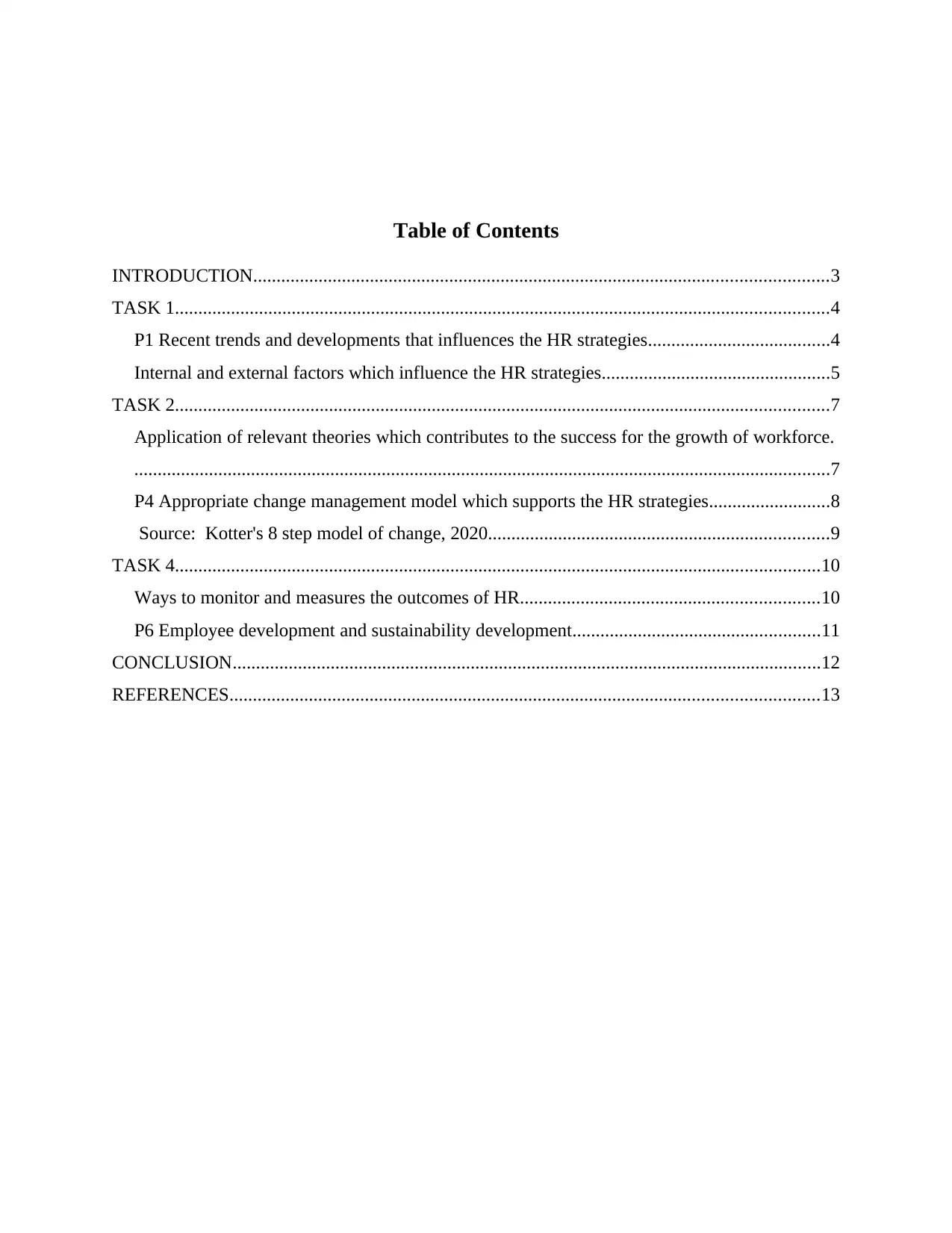
Table of Contents
INTRODUCTION...........................................................................................................................3
TASK 1............................................................................................................................................4
P1 Recent trends and developments that influences the HR strategies.......................................4
Internal and external factors which influence the HR strategies.................................................5
TASK 2............................................................................................................................................7
Application of relevant theories which contributes to the success for the growth of workforce.
.....................................................................................................................................................7
P4 Appropriate change management model which supports the HR strategies..........................8
Source: Kotter's 8 step model of change, 2020.........................................................................9
TASK 4..........................................................................................................................................10
Ways to monitor and measures the outcomes of HR................................................................10
P6 Employee development and sustainability development.....................................................11
CONCLUSION..............................................................................................................................12
REFERENCES..............................................................................................................................13
INTRODUCTION...........................................................................................................................3
TASK 1............................................................................................................................................4
P1 Recent trends and developments that influences the HR strategies.......................................4
Internal and external factors which influence the HR strategies.................................................5
TASK 2............................................................................................................................................7
Application of relevant theories which contributes to the success for the growth of workforce.
.....................................................................................................................................................7
P4 Appropriate change management model which supports the HR strategies..........................8
Source: Kotter's 8 step model of change, 2020.........................................................................9
TASK 4..........................................................................................................................................10
Ways to monitor and measures the outcomes of HR................................................................10
P6 Employee development and sustainability development.....................................................11
CONCLUSION..............................................................................................................................12
REFERENCES..............................................................................................................................13
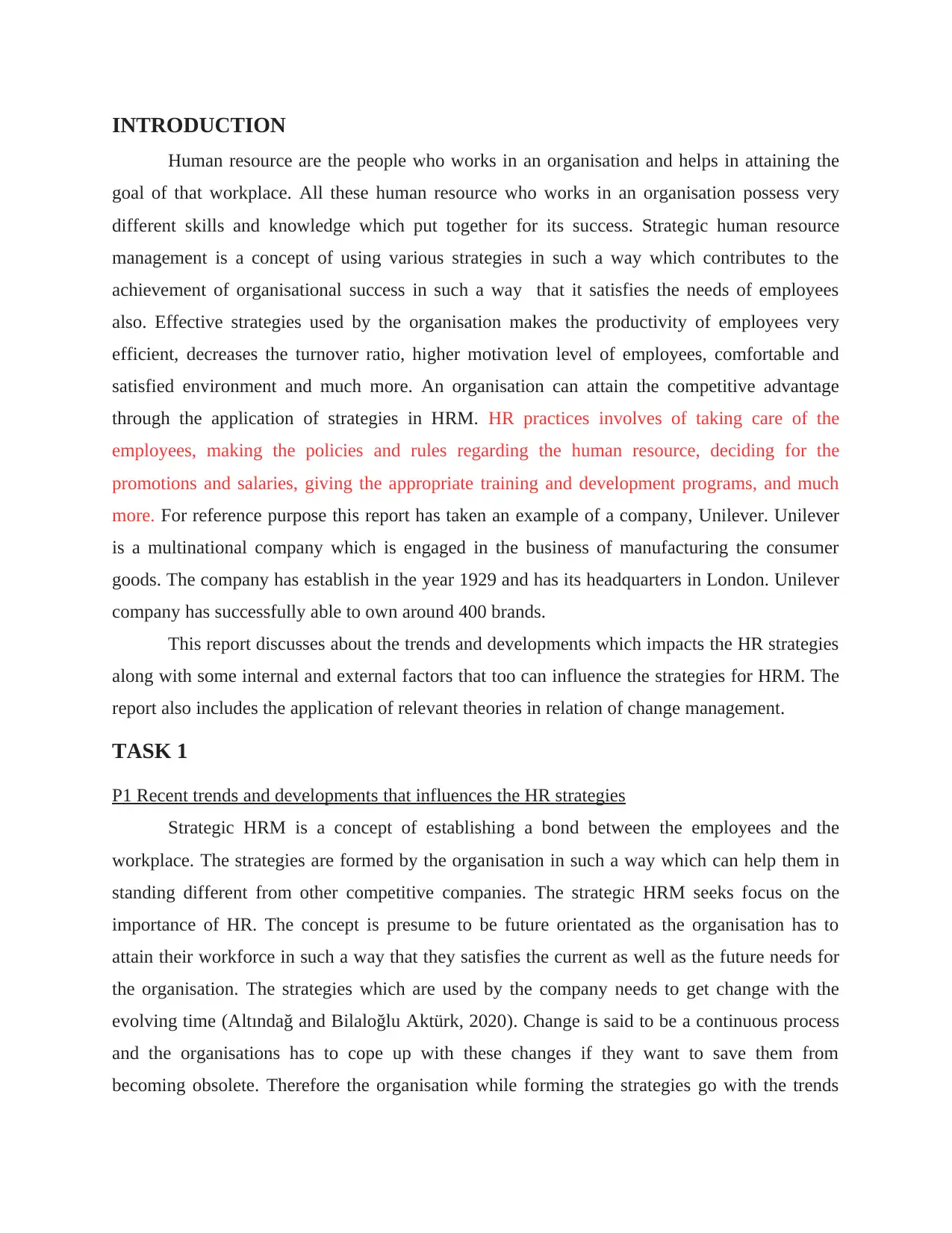
INTRODUCTION
Human resource are the people who works in an organisation and helps in attaining the
goal of that workplace. All these human resource who works in an organisation possess very
different skills and knowledge which put together for its success. Strategic human resource
management is a concept of using various strategies in such a way which contributes to the
achievement of organisational success in such a way that it satisfies the needs of employees
also. Effective strategies used by the organisation makes the productivity of employees very
efficient, decreases the turnover ratio, higher motivation level of employees, comfortable and
satisfied environment and much more. An organisation can attain the competitive advantage
through the application of strategies in HRM. HR practices involves of taking care of the
employees, making the policies and rules regarding the human resource, deciding for the
promotions and salaries, giving the appropriate training and development programs, and much
more. For reference purpose this report has taken an example of a company, Unilever. Unilever
is a multinational company which is engaged in the business of manufacturing the consumer
goods. The company has establish in the year 1929 and has its headquarters in London. Unilever
company has successfully able to own around 400 brands.
This report discusses about the trends and developments which impacts the HR strategies
along with some internal and external factors that too can influence the strategies for HRM. The
report also includes the application of relevant theories in relation of change management.
TASK 1
P1 Recent trends and developments that influences the HR strategies
Strategic HRM is a concept of establishing a bond between the employees and the
workplace. The strategies are formed by the organisation in such a way which can help them in
standing different from other competitive companies. The strategic HRM seeks focus on the
importance of HR. The concept is presume to be future orientated as the organisation has to
attain their workforce in such a way that they satisfies the current as well as the future needs for
the organisation. The strategies which are used by the company needs to get change with the
evolving time (Altındağ and Bilaloğlu Aktürk, 2020). Change is said to be a continuous process
and the organisations has to cope up with these changes if they want to save them from
becoming obsolete. Therefore the organisation while forming the strategies go with the trends
Human resource are the people who works in an organisation and helps in attaining the
goal of that workplace. All these human resource who works in an organisation possess very
different skills and knowledge which put together for its success. Strategic human resource
management is a concept of using various strategies in such a way which contributes to the
achievement of organisational success in such a way that it satisfies the needs of employees
also. Effective strategies used by the organisation makes the productivity of employees very
efficient, decreases the turnover ratio, higher motivation level of employees, comfortable and
satisfied environment and much more. An organisation can attain the competitive advantage
through the application of strategies in HRM. HR practices involves of taking care of the
employees, making the policies and rules regarding the human resource, deciding for the
promotions and salaries, giving the appropriate training and development programs, and much
more. For reference purpose this report has taken an example of a company, Unilever. Unilever
is a multinational company which is engaged in the business of manufacturing the consumer
goods. The company has establish in the year 1929 and has its headquarters in London. Unilever
company has successfully able to own around 400 brands.
This report discusses about the trends and developments which impacts the HR strategies
along with some internal and external factors that too can influence the strategies for HRM. The
report also includes the application of relevant theories in relation of change management.
TASK 1
P1 Recent trends and developments that influences the HR strategies
Strategic HRM is a concept of establishing a bond between the employees and the
workplace. The strategies are formed by the organisation in such a way which can help them in
standing different from other competitive companies. The strategic HRM seeks focus on the
importance of HR. The concept is presume to be future orientated as the organisation has to
attain their workforce in such a way that they satisfies the current as well as the future needs for
the organisation. The strategies which are used by the company needs to get change with the
evolving time (Altındağ and Bilaloğlu Aktürk, 2020). Change is said to be a continuous process
and the organisations has to cope up with these changes if they want to save them from
becoming obsolete. Therefore the organisation while forming the strategies go with the trends
⊘ This is a preview!⊘
Do you want full access?
Subscribe today to unlock all pages.

Trusted by 1+ million students worldwide
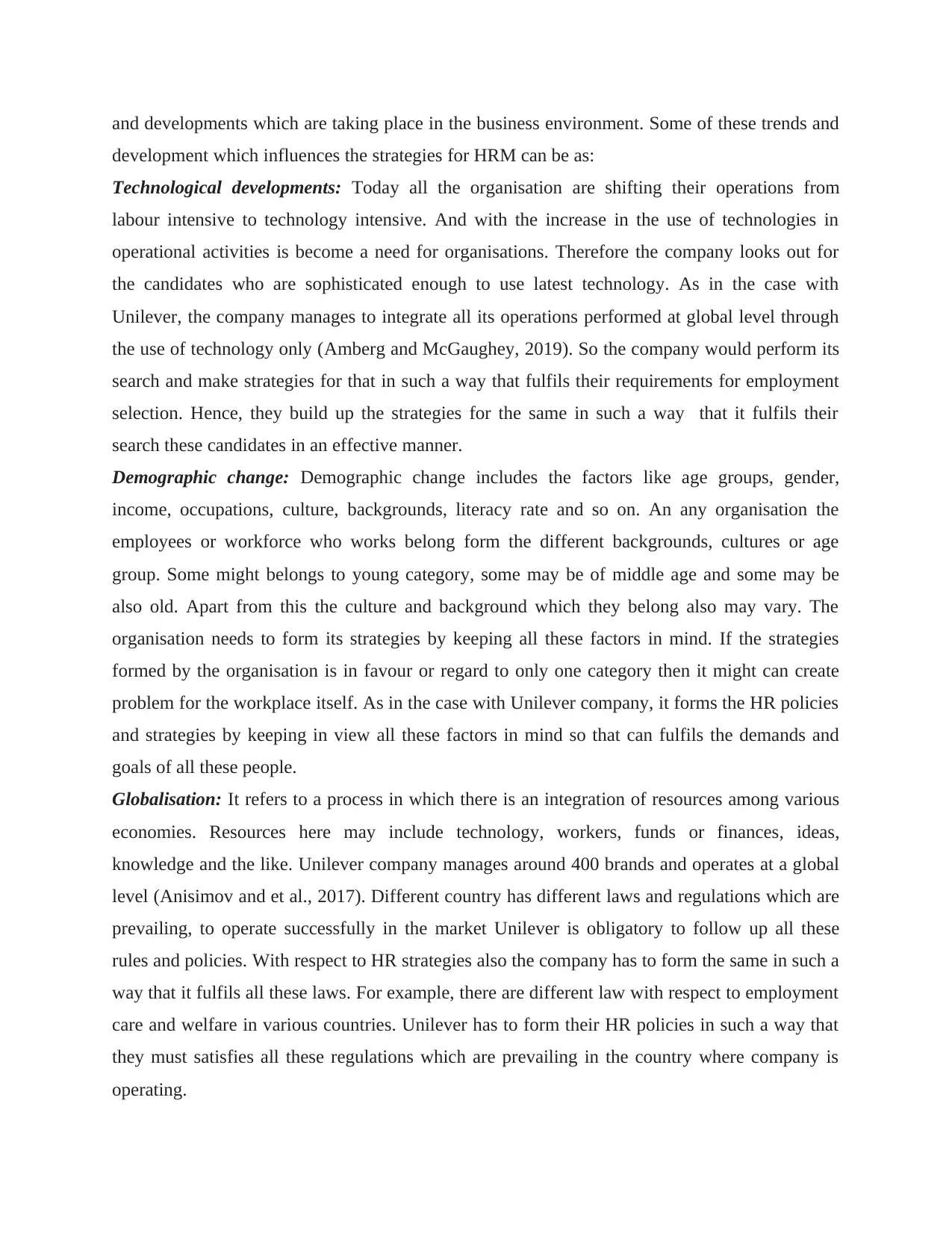
and developments which are taking place in the business environment. Some of these trends and
development which influences the strategies for HRM can be as:
Technological developments: Today all the organisation are shifting their operations from
labour intensive to technology intensive. And with the increase in the use of technologies in
operational activities is become a need for organisations. Therefore the company looks out for
the candidates who are sophisticated enough to use latest technology. As in the case with
Unilever, the company manages to integrate all its operations performed at global level through
the use of technology only (Amberg and McGaughey, 2019). So the company would perform its
search and make strategies for that in such a way that fulfils their requirements for employment
selection. Hence, they build up the strategies for the same in such a way that it fulfils their
search these candidates in an effective manner.
Demographic change: Demographic change includes the factors like age groups, gender,
income, occupations, culture, backgrounds, literacy rate and so on. An any organisation the
employees or workforce who works belong form the different backgrounds, cultures or age
group. Some might belongs to young category, some may be of middle age and some may be
also old. Apart from this the culture and background which they belong also may vary. The
organisation needs to form its strategies by keeping all these factors in mind. If the strategies
formed by the organisation is in favour or regard to only one category then it might can create
problem for the workplace itself. As in the case with Unilever company, it forms the HR policies
and strategies by keeping in view all these factors in mind so that can fulfils the demands and
goals of all these people.
Globalisation: It refers to a process in which there is an integration of resources among various
economies. Resources here may include technology, workers, funds or finances, ideas,
knowledge and the like. Unilever company manages around 400 brands and operates at a global
level (Anisimov and et al., 2017). Different country has different laws and regulations which are
prevailing, to operate successfully in the market Unilever is obligatory to follow up all these
rules and policies. With respect to HR strategies also the company has to form the same in such a
way that it fulfils all these laws. For example, there are different law with respect to employment
care and welfare in various countries. Unilever has to form their HR policies in such a way that
they must satisfies all these regulations which are prevailing in the country where company is
operating.
development which influences the strategies for HRM can be as:
Technological developments: Today all the organisation are shifting their operations from
labour intensive to technology intensive. And with the increase in the use of technologies in
operational activities is become a need for organisations. Therefore the company looks out for
the candidates who are sophisticated enough to use latest technology. As in the case with
Unilever, the company manages to integrate all its operations performed at global level through
the use of technology only (Amberg and McGaughey, 2019). So the company would perform its
search and make strategies for that in such a way that fulfils their requirements for employment
selection. Hence, they build up the strategies for the same in such a way that it fulfils their
search these candidates in an effective manner.
Demographic change: Demographic change includes the factors like age groups, gender,
income, occupations, culture, backgrounds, literacy rate and so on. An any organisation the
employees or workforce who works belong form the different backgrounds, cultures or age
group. Some might belongs to young category, some may be of middle age and some may be
also old. Apart from this the culture and background which they belong also may vary. The
organisation needs to form its strategies by keeping all these factors in mind. If the strategies
formed by the organisation is in favour or regard to only one category then it might can create
problem for the workplace itself. As in the case with Unilever company, it forms the HR policies
and strategies by keeping in view all these factors in mind so that can fulfils the demands and
goals of all these people.
Globalisation: It refers to a process in which there is an integration of resources among various
economies. Resources here may include technology, workers, funds or finances, ideas,
knowledge and the like. Unilever company manages around 400 brands and operates at a global
level (Anisimov and et al., 2017). Different country has different laws and regulations which are
prevailing, to operate successfully in the market Unilever is obligatory to follow up all these
rules and policies. With respect to HR strategies also the company has to form the same in such a
way that it fulfils all these laws. For example, there are different law with respect to employment
care and welfare in various countries. Unilever has to form their HR policies in such a way that
they must satisfies all these regulations which are prevailing in the country where company is
operating.
Paraphrase This Document
Need a fresh take? Get an instant paraphrase of this document with our AI Paraphraser
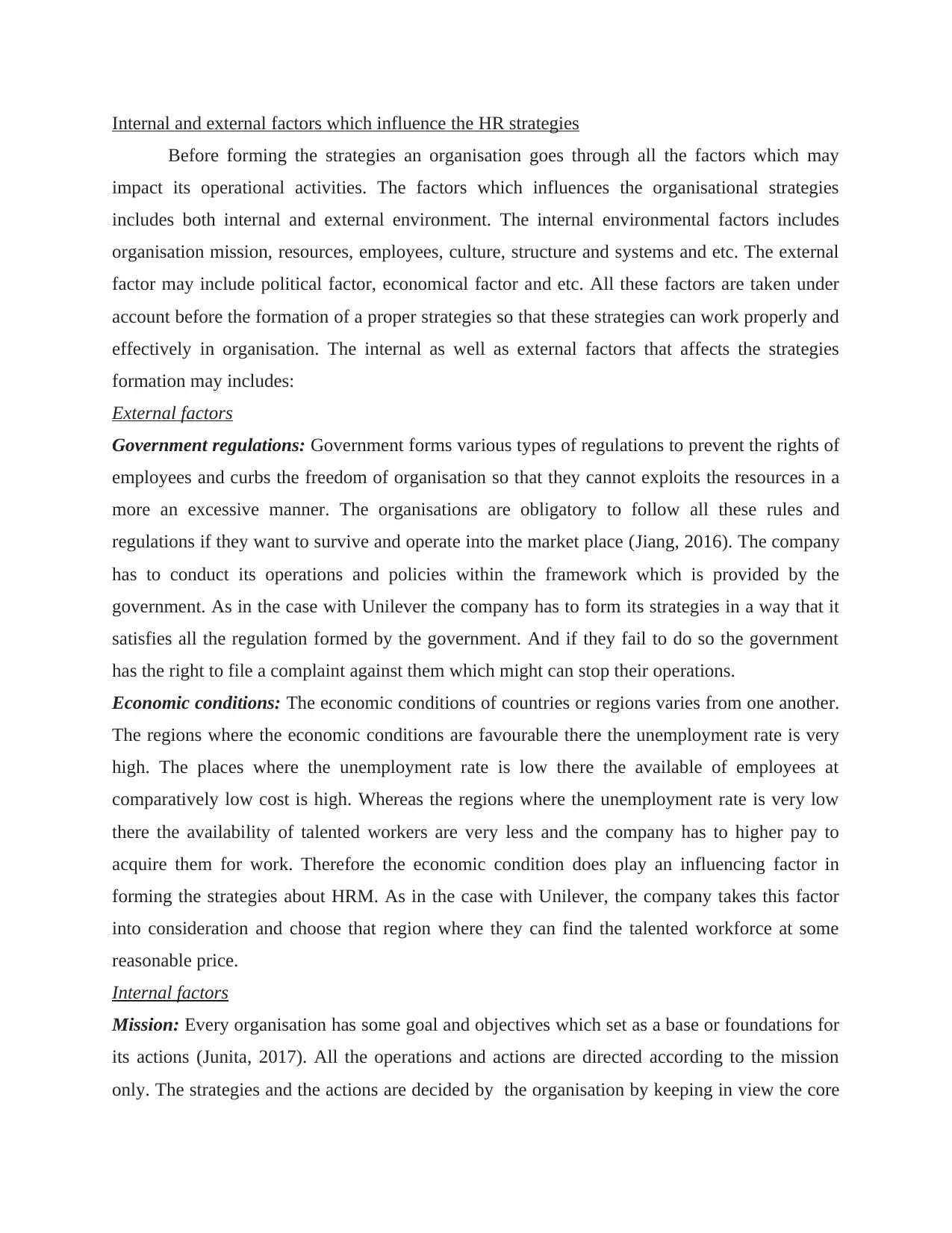
Internal and external factors which influence the HR strategies
Before forming the strategies an organisation goes through all the factors which may
impact its operational activities. The factors which influences the organisational strategies
includes both internal and external environment. The internal environmental factors includes
organisation mission, resources, employees, culture, structure and systems and etc. The external
factor may include political factor, economical factor and etc. All these factors are taken under
account before the formation of a proper strategies so that these strategies can work properly and
effectively in organisation. The internal as well as external factors that affects the strategies
formation may includes:
External factors
Government regulations: Government forms various types of regulations to prevent the rights of
employees and curbs the freedom of organisation so that they cannot exploits the resources in a
more an excessive manner. The organisations are obligatory to follow all these rules and
regulations if they want to survive and operate into the market place (Jiang, 2016). The company
has to conduct its operations and policies within the framework which is provided by the
government. As in the case with Unilever the company has to form its strategies in a way that it
satisfies all the regulation formed by the government. And if they fail to do so the government
has the right to file a complaint against them which might can stop their operations.
Economic conditions: The economic conditions of countries or regions varies from one another.
The regions where the economic conditions are favourable there the unemployment rate is very
high. The places where the unemployment rate is low there the available of employees at
comparatively low cost is high. Whereas the regions where the unemployment rate is very low
there the availability of talented workers are very less and the company has to higher pay to
acquire them for work. Therefore the economic condition does play an influencing factor in
forming the strategies about HRM. As in the case with Unilever, the company takes this factor
into consideration and choose that region where they can find the talented workforce at some
reasonable price.
Internal factors
Mission: Every organisation has some goal and objectives which set as a base or foundations for
its actions (Junita, 2017). All the operations and actions are directed according to the mission
only. The strategies and the actions are decided by the organisation by keeping in view the core
Before forming the strategies an organisation goes through all the factors which may
impact its operational activities. The factors which influences the organisational strategies
includes both internal and external environment. The internal environmental factors includes
organisation mission, resources, employees, culture, structure and systems and etc. The external
factor may include political factor, economical factor and etc. All these factors are taken under
account before the formation of a proper strategies so that these strategies can work properly and
effectively in organisation. The internal as well as external factors that affects the strategies
formation may includes:
External factors
Government regulations: Government forms various types of regulations to prevent the rights of
employees and curbs the freedom of organisation so that they cannot exploits the resources in a
more an excessive manner. The organisations are obligatory to follow all these rules and
regulations if they want to survive and operate into the market place (Jiang, 2016). The company
has to conduct its operations and policies within the framework which is provided by the
government. As in the case with Unilever the company has to form its strategies in a way that it
satisfies all the regulation formed by the government. And if they fail to do so the government
has the right to file a complaint against them which might can stop their operations.
Economic conditions: The economic conditions of countries or regions varies from one another.
The regions where the economic conditions are favourable there the unemployment rate is very
high. The places where the unemployment rate is low there the available of employees at
comparatively low cost is high. Whereas the regions where the unemployment rate is very low
there the availability of talented workers are very less and the company has to higher pay to
acquire them for work. Therefore the economic condition does play an influencing factor in
forming the strategies about HRM. As in the case with Unilever, the company takes this factor
into consideration and choose that region where they can find the talented workforce at some
reasonable price.
Internal factors
Mission: Every organisation has some goal and objectives which set as a base or foundations for
its actions (Junita, 2017). All the operations and actions are directed according to the mission
only. The strategies and the actions are decided by the organisation by keeping in view the core
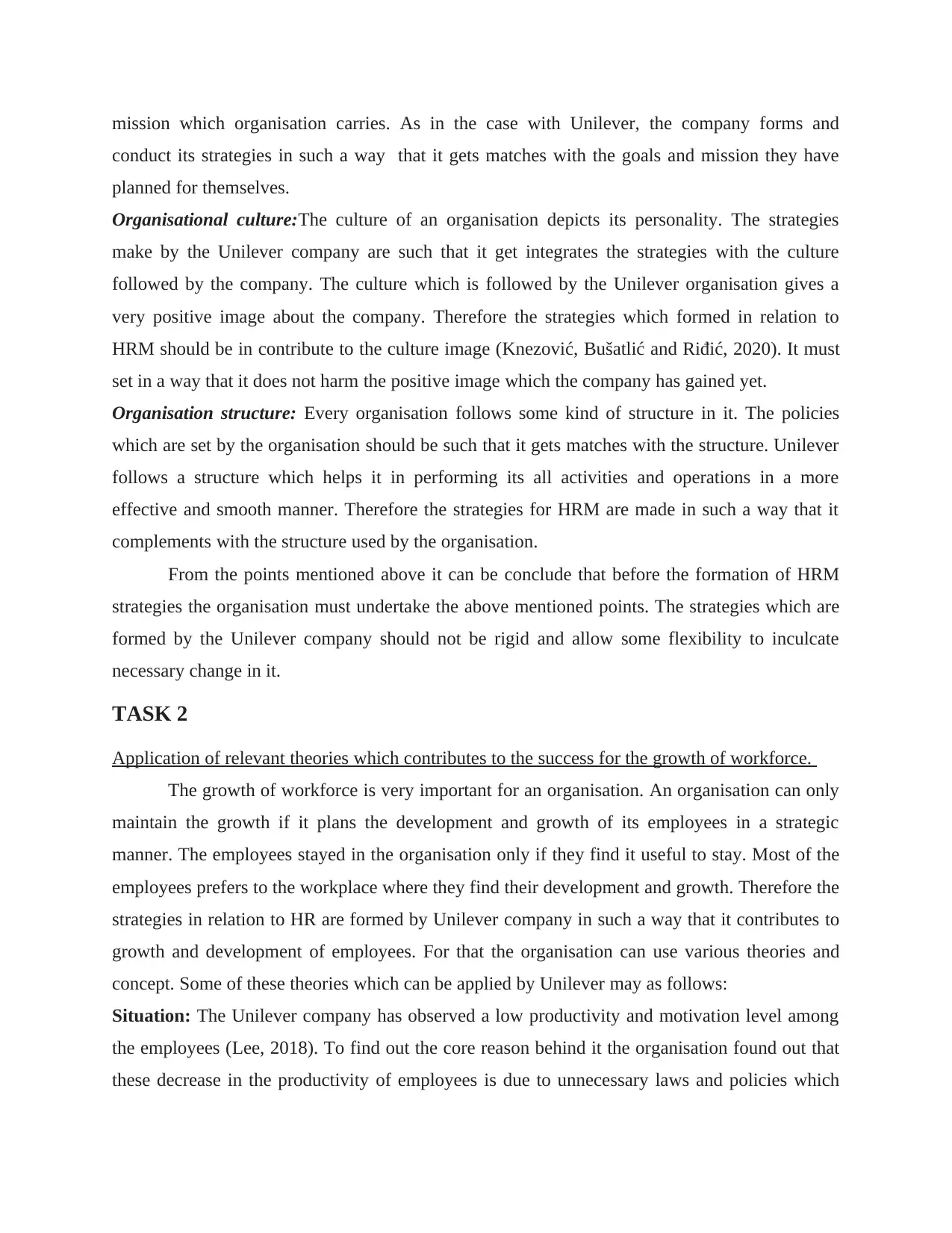
mission which organisation carries. As in the case with Unilever, the company forms and
conduct its strategies in such a way that it gets matches with the goals and mission they have
planned for themselves.
Organisational culture:The culture of an organisation depicts its personality. The strategies
make by the Unilever company are such that it get integrates the strategies with the culture
followed by the company. The culture which is followed by the Unilever organisation gives a
very positive image about the company. Therefore the strategies which formed in relation to
HRM should be in contribute to the culture image (Knezović, Bušatlić and Riđić, 2020). It must
set in a way that it does not harm the positive image which the company has gained yet.
Organisation structure: Every organisation follows some kind of structure in it. The policies
which are set by the organisation should be such that it gets matches with the structure. Unilever
follows a structure which helps it in performing its all activities and operations in a more
effective and smooth manner. Therefore the strategies for HRM are made in such a way that it
complements with the structure used by the organisation.
From the points mentioned above it can be conclude that before the formation of HRM
strategies the organisation must undertake the above mentioned points. The strategies which are
formed by the Unilever company should not be rigid and allow some flexibility to inculcate
necessary change in it.
TASK 2
Application of relevant theories which contributes to the success for the growth of workforce.
The growth of workforce is very important for an organisation. An organisation can only
maintain the growth if it plans the development and growth of its employees in a strategic
manner. The employees stayed in the organisation only if they find it useful to stay. Most of the
employees prefers to the workplace where they find their development and growth. Therefore the
strategies in relation to HR are formed by Unilever company in such a way that it contributes to
growth and development of employees. For that the organisation can use various theories and
concept. Some of these theories which can be applied by Unilever may as follows:
Situation: The Unilever company has observed a low productivity and motivation level among
the employees (Lee, 2018). To find out the core reason behind it the organisation found out that
these decrease in the productivity of employees is due to unnecessary laws and policies which
conduct its strategies in such a way that it gets matches with the goals and mission they have
planned for themselves.
Organisational culture:The culture of an organisation depicts its personality. The strategies
make by the Unilever company are such that it get integrates the strategies with the culture
followed by the company. The culture which is followed by the Unilever organisation gives a
very positive image about the company. Therefore the strategies which formed in relation to
HRM should be in contribute to the culture image (Knezović, Bušatlić and Riđić, 2020). It must
set in a way that it does not harm the positive image which the company has gained yet.
Organisation structure: Every organisation follows some kind of structure in it. The policies
which are set by the organisation should be such that it gets matches with the structure. Unilever
follows a structure which helps it in performing its all activities and operations in a more
effective and smooth manner. Therefore the strategies for HRM are made in such a way that it
complements with the structure used by the organisation.
From the points mentioned above it can be conclude that before the formation of HRM
strategies the organisation must undertake the above mentioned points. The strategies which are
formed by the Unilever company should not be rigid and allow some flexibility to inculcate
necessary change in it.
TASK 2
Application of relevant theories which contributes to the success for the growth of workforce.
The growth of workforce is very important for an organisation. An organisation can only
maintain the growth if it plans the development and growth of its employees in a strategic
manner. The employees stayed in the organisation only if they find it useful to stay. Most of the
employees prefers to the workplace where they find their development and growth. Therefore the
strategies in relation to HR are formed by Unilever company in such a way that it contributes to
growth and development of employees. For that the organisation can use various theories and
concept. Some of these theories which can be applied by Unilever may as follows:
Situation: The Unilever company has observed a low productivity and motivation level among
the employees (Lee, 2018). To find out the core reason behind it the organisation found out that
these decrease in the productivity of employees is due to unnecessary laws and policies which
⊘ This is a preview!⊘
Do you want full access?
Subscribe today to unlock all pages.

Trusted by 1+ million students worldwide
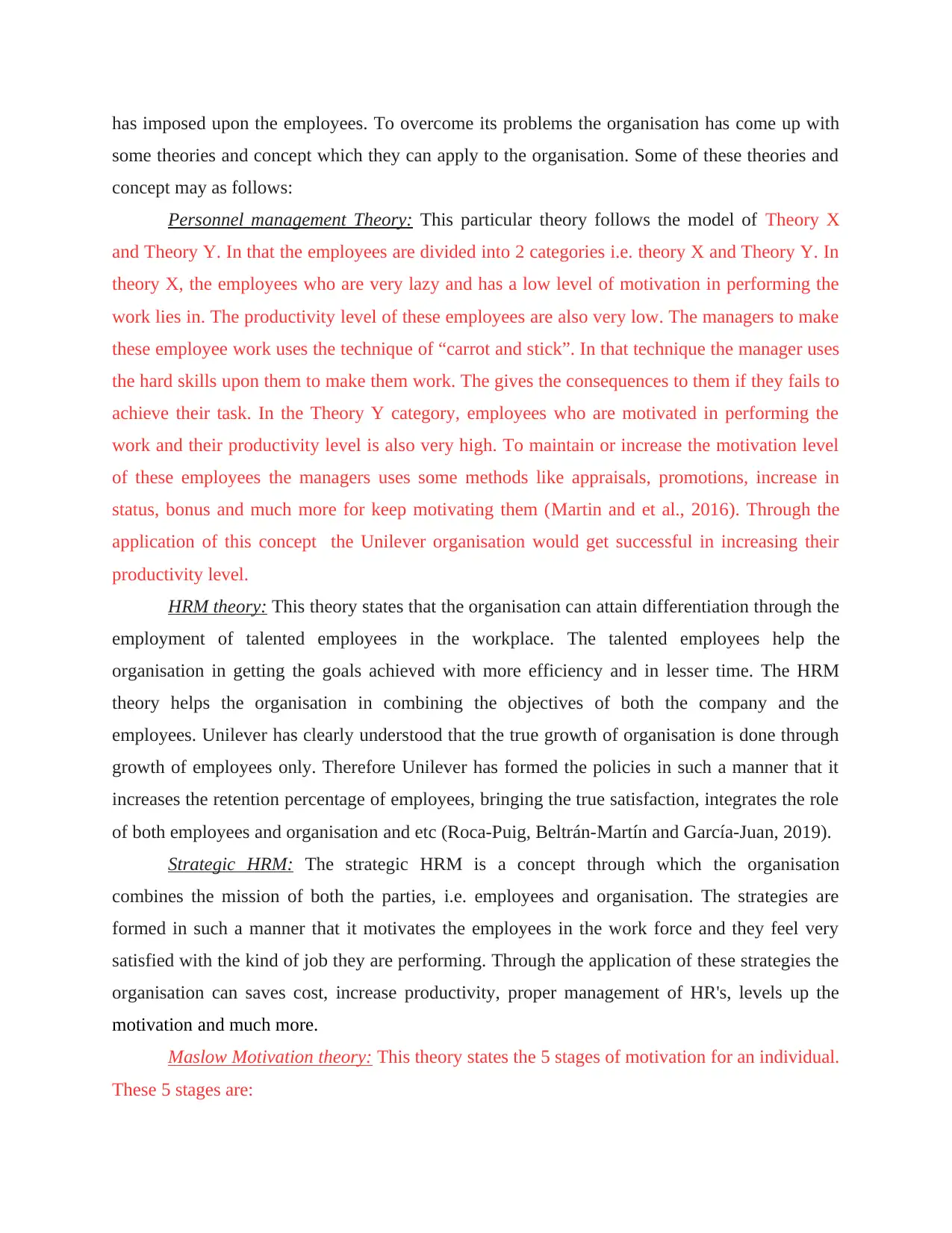
has imposed upon the employees. To overcome its problems the organisation has come up with
some theories and concept which they can apply to the organisation. Some of these theories and
concept may as follows:
Personnel management Theory: This particular theory follows the model of Theory X
and Theory Y. In that the employees are divided into 2 categories i.e. theory X and Theory Y. In
theory X, the employees who are very lazy and has a low level of motivation in performing the
work lies in. The productivity level of these employees are also very low. The managers to make
these employee work uses the technique of “carrot and stick”. In that technique the manager uses
the hard skills upon them to make them work. The gives the consequences to them if they fails to
achieve their task. In the Theory Y category, employees who are motivated in performing the
work and their productivity level is also very high. To maintain or increase the motivation level
of these employees the managers uses some methods like appraisals, promotions, increase in
status, bonus and much more for keep motivating them (Martin and et al., 2016). Through the
application of this concept the Unilever organisation would get successful in increasing their
productivity level.
HRM theory: This theory states that the organisation can attain differentiation through the
employment of talented employees in the workplace. The talented employees help the
organisation in getting the goals achieved with more efficiency and in lesser time. The HRM
theory helps the organisation in combining the objectives of both the company and the
employees. Unilever has clearly understood that the true growth of organisation is done through
growth of employees only. Therefore Unilever has formed the policies in such a manner that it
increases the retention percentage of employees, bringing the true satisfaction, integrates the role
of both employees and organisation and etc (Roca-Puig, Beltrán-Martín and García-Juan, 2019).
Strategic HRM: The strategic HRM is a concept through which the organisation
combines the mission of both the parties, i.e. employees and organisation. The strategies are
formed in such a manner that it motivates the employees in the work force and they feel very
satisfied with the kind of job they are performing. Through the application of these strategies the
organisation can saves cost, increase productivity, proper management of HR's, levels up the
motivation and much more.
Maslow Motivation theory: This theory states the 5 stages of motivation for an individual.
These 5 stages are:
some theories and concept which they can apply to the organisation. Some of these theories and
concept may as follows:
Personnel management Theory: This particular theory follows the model of Theory X
and Theory Y. In that the employees are divided into 2 categories i.e. theory X and Theory Y. In
theory X, the employees who are very lazy and has a low level of motivation in performing the
work lies in. The productivity level of these employees are also very low. The managers to make
these employee work uses the technique of “carrot and stick”. In that technique the manager uses
the hard skills upon them to make them work. The gives the consequences to them if they fails to
achieve their task. In the Theory Y category, employees who are motivated in performing the
work and their productivity level is also very high. To maintain or increase the motivation level
of these employees the managers uses some methods like appraisals, promotions, increase in
status, bonus and much more for keep motivating them (Martin and et al., 2016). Through the
application of this concept the Unilever organisation would get successful in increasing their
productivity level.
HRM theory: This theory states that the organisation can attain differentiation through the
employment of talented employees in the workplace. The talented employees help the
organisation in getting the goals achieved with more efficiency and in lesser time. The HRM
theory helps the organisation in combining the objectives of both the company and the
employees. Unilever has clearly understood that the true growth of organisation is done through
growth of employees only. Therefore Unilever has formed the policies in such a manner that it
increases the retention percentage of employees, bringing the true satisfaction, integrates the role
of both employees and organisation and etc (Roca-Puig, Beltrán-Martín and García-Juan, 2019).
Strategic HRM: The strategic HRM is a concept through which the organisation
combines the mission of both the parties, i.e. employees and organisation. The strategies are
formed in such a manner that it motivates the employees in the work force and they feel very
satisfied with the kind of job they are performing. Through the application of these strategies the
organisation can saves cost, increase productivity, proper management of HR's, levels up the
motivation and much more.
Maslow Motivation theory: This theory states the 5 stages of motivation for an individual.
These 5 stages are:
Paraphrase This Document
Need a fresh take? Get an instant paraphrase of this document with our AI Paraphraser
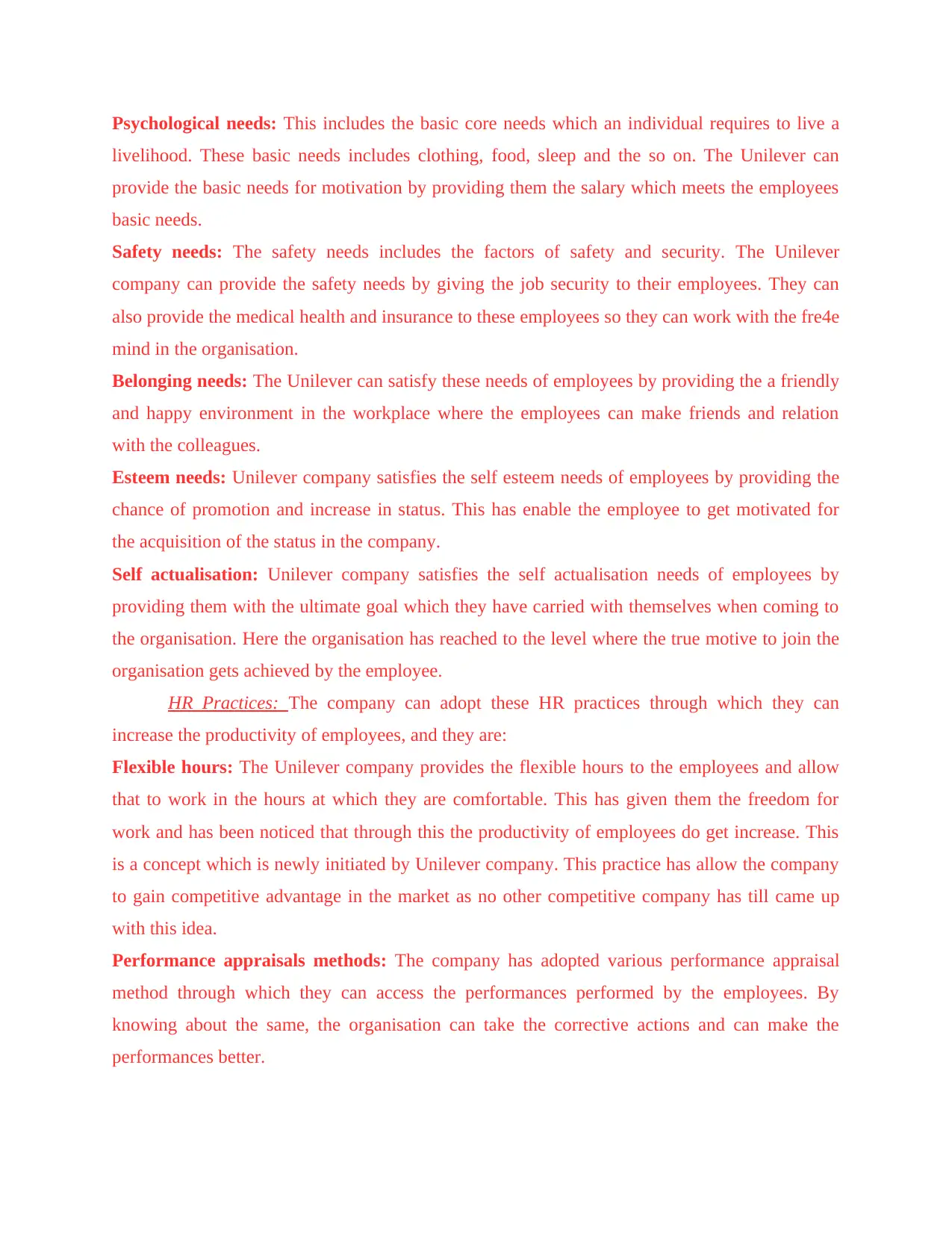
Psychological needs: This includes the basic core needs which an individual requires to live a
livelihood. These basic needs includes clothing, food, sleep and the so on. The Unilever can
provide the basic needs for motivation by providing them the salary which meets the employees
basic needs.
Safety needs: The safety needs includes the factors of safety and security. The Unilever
company can provide the safety needs by giving the job security to their employees. They can
also provide the medical health and insurance to these employees so they can work with the fre4e
mind in the organisation.
Belonging needs: The Unilever can satisfy these needs of employees by providing the a friendly
and happy environment in the workplace where the employees can make friends and relation
with the colleagues.
Esteem needs: Unilever company satisfies the self esteem needs of employees by providing the
chance of promotion and increase in status. This has enable the employee to get motivated for
the acquisition of the status in the company.
Self actualisation: Unilever company satisfies the self actualisation needs of employees by
providing them with the ultimate goal which they have carried with themselves when coming to
the organisation. Here the organisation has reached to the level where the true motive to join the
organisation gets achieved by the employee.
HR Practices: The company can adopt these HR practices through which they can
increase the productivity of employees, and they are:
Flexible hours: The Unilever company provides the flexible hours to the employees and allow
that to work in the hours at which they are comfortable. This has given them the freedom for
work and has been noticed that through this the productivity of employees do get increase. This
is a concept which is newly initiated by Unilever company. This practice has allow the company
to gain competitive advantage in the market as no other competitive company has till came up
with this idea.
Performance appraisals methods: The company has adopted various performance appraisal
method through which they can access the performances performed by the employees. By
knowing about the same, the organisation can take the corrective actions and can make the
performances better.
livelihood. These basic needs includes clothing, food, sleep and the so on. The Unilever can
provide the basic needs for motivation by providing them the salary which meets the employees
basic needs.
Safety needs: The safety needs includes the factors of safety and security. The Unilever
company can provide the safety needs by giving the job security to their employees. They can
also provide the medical health and insurance to these employees so they can work with the fre4e
mind in the organisation.
Belonging needs: The Unilever can satisfy these needs of employees by providing the a friendly
and happy environment in the workplace where the employees can make friends and relation
with the colleagues.
Esteem needs: Unilever company satisfies the self esteem needs of employees by providing the
chance of promotion and increase in status. This has enable the employee to get motivated for
the acquisition of the status in the company.
Self actualisation: Unilever company satisfies the self actualisation needs of employees by
providing them with the ultimate goal which they have carried with themselves when coming to
the organisation. Here the organisation has reached to the level where the true motive to join the
organisation gets achieved by the employee.
HR Practices: The company can adopt these HR practices through which they can
increase the productivity of employees, and they are:
Flexible hours: The Unilever company provides the flexible hours to the employees and allow
that to work in the hours at which they are comfortable. This has given them the freedom for
work and has been noticed that through this the productivity of employees do get increase. This
is a concept which is newly initiated by Unilever company. This practice has allow the company
to gain competitive advantage in the market as no other competitive company has till came up
with this idea.
Performance appraisals methods: The company has adopted various performance appraisal
method through which they can access the performances performed by the employees. By
knowing about the same, the organisation can take the corrective actions and can make the
performances better.
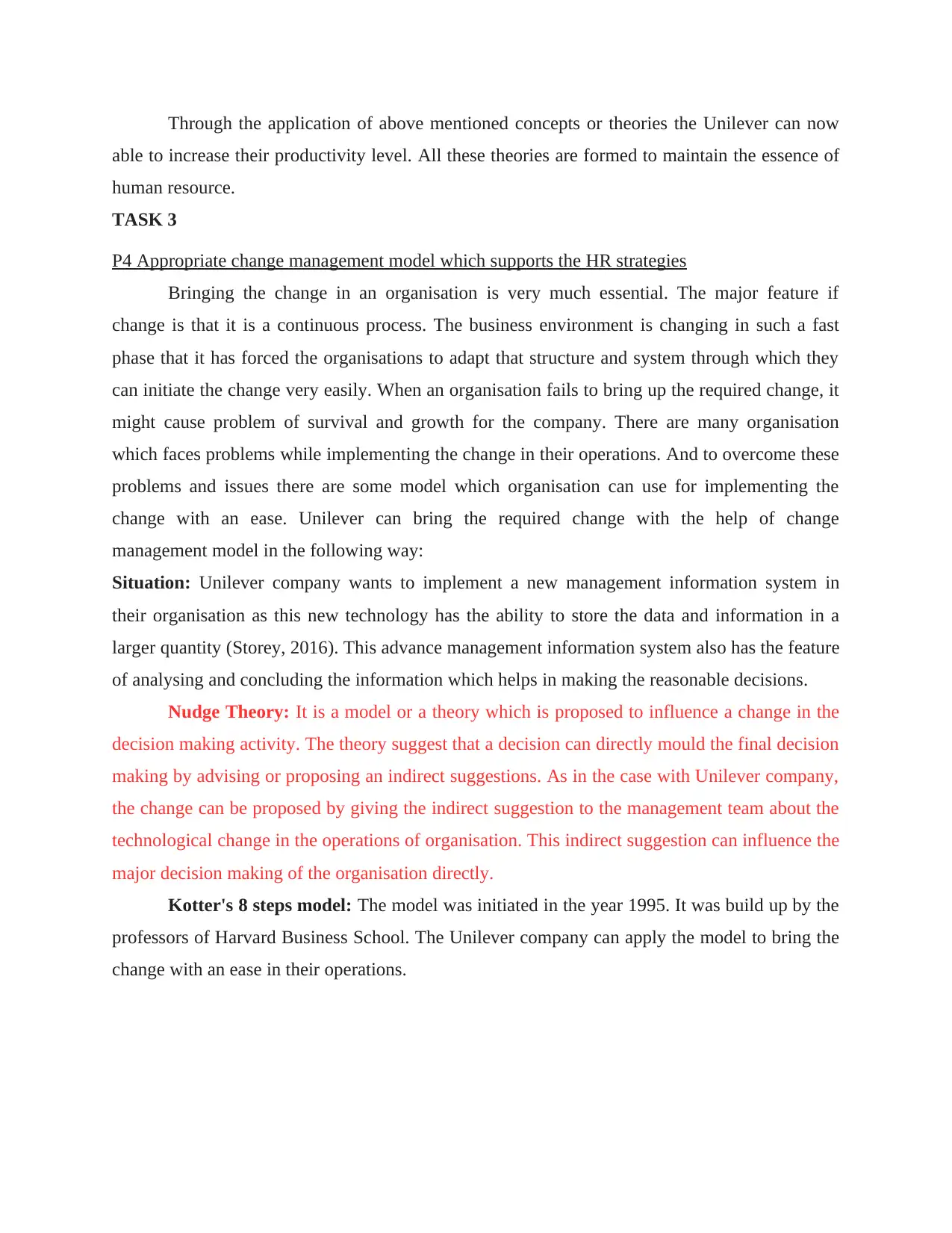
Through the application of above mentioned concepts or theories the Unilever can now
able to increase their productivity level. All these theories are formed to maintain the essence of
human resource.
TASK 3
P4 Appropriate change management model which supports the HR strategies
Bringing the change in an organisation is very much essential. The major feature if
change is that it is a continuous process. The business environment is changing in such a fast
phase that it has forced the organisations to adapt that structure and system through which they
can initiate the change very easily. When an organisation fails to bring up the required change, it
might cause problem of survival and growth for the company. There are many organisation
which faces problems while implementing the change in their operations. And to overcome these
problems and issues there are some model which organisation can use for implementing the
change with an ease. Unilever can bring the required change with the help of change
management model in the following way:
Situation: Unilever company wants to implement a new management information system in
their organisation as this new technology has the ability to store the data and information in a
larger quantity (Storey, 2016). This advance management information system also has the feature
of analysing and concluding the information which helps in making the reasonable decisions.
Nudge Theory: It is a model or a theory which is proposed to influence a change in the
decision making activity. The theory suggest that a decision can directly mould the final decision
making by advising or proposing an indirect suggestions. As in the case with Unilever company,
the change can be proposed by giving the indirect suggestion to the management team about the
technological change in the operations of organisation. This indirect suggestion can influence the
major decision making of the organisation directly.
Kotter's 8 steps model: The model was initiated in the year 1995. It was build up by the
professors of Harvard Business School. The Unilever company can apply the model to bring the
change with an ease in their operations.
able to increase their productivity level. All these theories are formed to maintain the essence of
human resource.
TASK 3
P4 Appropriate change management model which supports the HR strategies
Bringing the change in an organisation is very much essential. The major feature if
change is that it is a continuous process. The business environment is changing in such a fast
phase that it has forced the organisations to adapt that structure and system through which they
can initiate the change very easily. When an organisation fails to bring up the required change, it
might cause problem of survival and growth for the company. There are many organisation
which faces problems while implementing the change in their operations. And to overcome these
problems and issues there are some model which organisation can use for implementing the
change with an ease. Unilever can bring the required change with the help of change
management model in the following way:
Situation: Unilever company wants to implement a new management information system in
their organisation as this new technology has the ability to store the data and information in a
larger quantity (Storey, 2016). This advance management information system also has the feature
of analysing and concluding the information which helps in making the reasonable decisions.
Nudge Theory: It is a model or a theory which is proposed to influence a change in the
decision making activity. The theory suggest that a decision can directly mould the final decision
making by advising or proposing an indirect suggestions. As in the case with Unilever company,
the change can be proposed by giving the indirect suggestion to the management team about the
technological change in the operations of organisation. This indirect suggestion can influence the
major decision making of the organisation directly.
Kotter's 8 steps model: The model was initiated in the year 1995. It was build up by the
professors of Harvard Business School. The Unilever company can apply the model to bring the
change with an ease in their operations.
⊘ This is a preview!⊘
Do you want full access?
Subscribe today to unlock all pages.

Trusted by 1+ million students worldwide
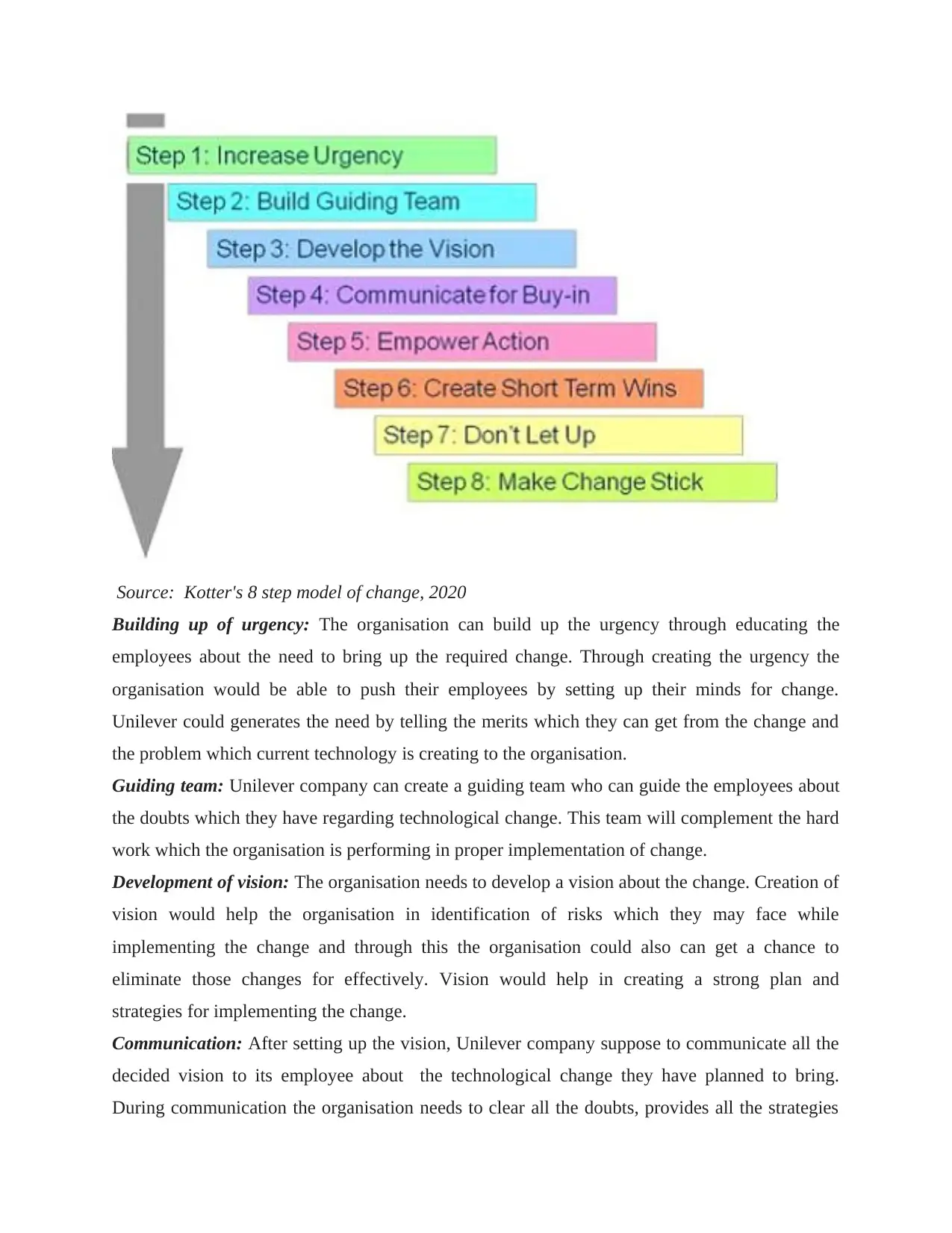
Source: Kotter's 8 step model of change, 2020
Building up of urgency: The organisation can build up the urgency through educating the
employees about the need to bring up the required change. Through creating the urgency the
organisation would be able to push their employees by setting up their minds for change.
Unilever could generates the need by telling the merits which they can get from the change and
the problem which current technology is creating to the organisation.
Guiding team: Unilever company can create a guiding team who can guide the employees about
the doubts which they have regarding technological change. This team will complement the hard
work which the organisation is performing in proper implementation of change.
Development of vision: The organisation needs to develop a vision about the change. Creation of
vision would help the organisation in identification of risks which they may face while
implementing the change and through this the organisation could also can get a chance to
eliminate those changes for effectively. Vision would help in creating a strong plan and
strategies for implementing the change.
Communication: After setting up the vision, Unilever company suppose to communicate all the
decided vision to its employee about the technological change they have planned to bring.
During communication the organisation needs to clear all the doubts, provides all the strategies
Building up of urgency: The organisation can build up the urgency through educating the
employees about the need to bring up the required change. Through creating the urgency the
organisation would be able to push their employees by setting up their minds for change.
Unilever could generates the need by telling the merits which they can get from the change and
the problem which current technology is creating to the organisation.
Guiding team: Unilever company can create a guiding team who can guide the employees about
the doubts which they have regarding technological change. This team will complement the hard
work which the organisation is performing in proper implementation of change.
Development of vision: The organisation needs to develop a vision about the change. Creation of
vision would help the organisation in identification of risks which they may face while
implementing the change and through this the organisation could also can get a chance to
eliminate those changes for effectively. Vision would help in creating a strong plan and
strategies for implementing the change.
Communication: After setting up the vision, Unilever company suppose to communicate all the
decided vision to its employee about the technological change they have planned to bring.
During communication the organisation needs to clear all the doubts, provides all the strategies
Paraphrase This Document
Need a fresh take? Get an instant paraphrase of this document with our AI Paraphraser
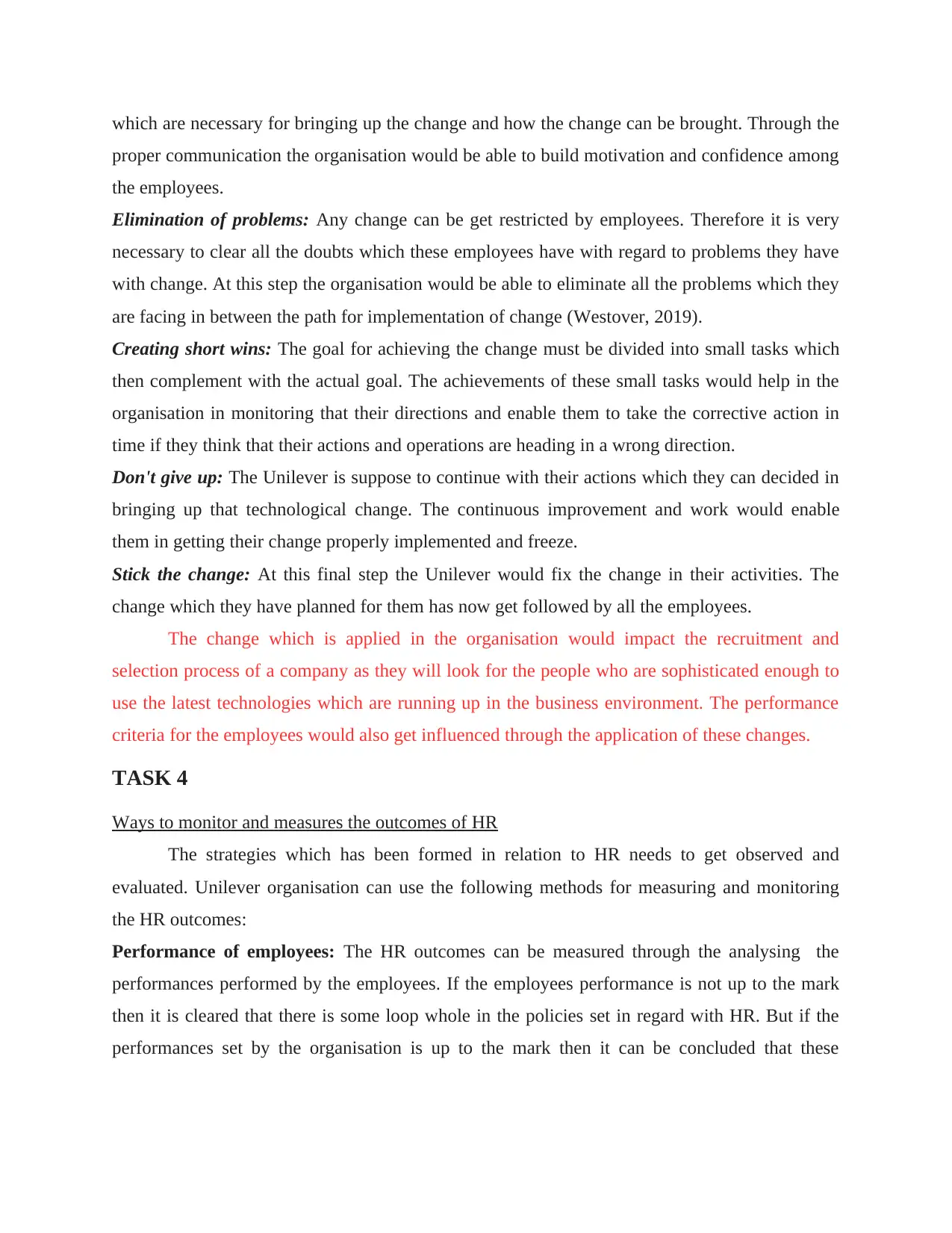
which are necessary for bringing up the change and how the change can be brought. Through the
proper communication the organisation would be able to build motivation and confidence among
the employees.
Elimination of problems: Any change can be get restricted by employees. Therefore it is very
necessary to clear all the doubts which these employees have with regard to problems they have
with change. At this step the organisation would be able to eliminate all the problems which they
are facing in between the path for implementation of change (Westover, 2019).
Creating short wins: The goal for achieving the change must be divided into small tasks which
then complement with the actual goal. The achievements of these small tasks would help in the
organisation in monitoring that their directions and enable them to take the corrective action in
time if they think that their actions and operations are heading in a wrong direction.
Don't give up: The Unilever is suppose to continue with their actions which they can decided in
bringing up that technological change. The continuous improvement and work would enable
them in getting their change properly implemented and freeze.
Stick the change: At this final step the Unilever would fix the change in their activities. The
change which they have planned for them has now get followed by all the employees.
The change which is applied in the organisation would impact the recruitment and
selection process of a company as they will look for the people who are sophisticated enough to
use the latest technologies which are running up in the business environment. The performance
criteria for the employees would also get influenced through the application of these changes.
TASK 4
Ways to monitor and measures the outcomes of HR
The strategies which has been formed in relation to HR needs to get observed and
evaluated. Unilever organisation can use the following methods for measuring and monitoring
the HR outcomes:
Performance of employees: The HR outcomes can be measured through the analysing the
performances performed by the employees. If the employees performance is not up to the mark
then it is cleared that there is some loop whole in the policies set in regard with HR. But if the
performances set by the organisation is up to the mark then it can be concluded that these
proper communication the organisation would be able to build motivation and confidence among
the employees.
Elimination of problems: Any change can be get restricted by employees. Therefore it is very
necessary to clear all the doubts which these employees have with regard to problems they have
with change. At this step the organisation would be able to eliminate all the problems which they
are facing in between the path for implementation of change (Westover, 2019).
Creating short wins: The goal for achieving the change must be divided into small tasks which
then complement with the actual goal. The achievements of these small tasks would help in the
organisation in monitoring that their directions and enable them to take the corrective action in
time if they think that their actions and operations are heading in a wrong direction.
Don't give up: The Unilever is suppose to continue with their actions which they can decided in
bringing up that technological change. The continuous improvement and work would enable
them in getting their change properly implemented and freeze.
Stick the change: At this final step the Unilever would fix the change in their activities. The
change which they have planned for them has now get followed by all the employees.
The change which is applied in the organisation would impact the recruitment and
selection process of a company as they will look for the people who are sophisticated enough to
use the latest technologies which are running up in the business environment. The performance
criteria for the employees would also get influenced through the application of these changes.
TASK 4
Ways to monitor and measures the outcomes of HR
The strategies which has been formed in relation to HR needs to get observed and
evaluated. Unilever organisation can use the following methods for measuring and monitoring
the HR outcomes:
Performance of employees: The HR outcomes can be measured through the analysing the
performances performed by the employees. If the employees performance is not up to the mark
then it is cleared that there is some loop whole in the policies set in regard with HR. But if the
performances set by the organisation is up to the mark then it can be concluded that these
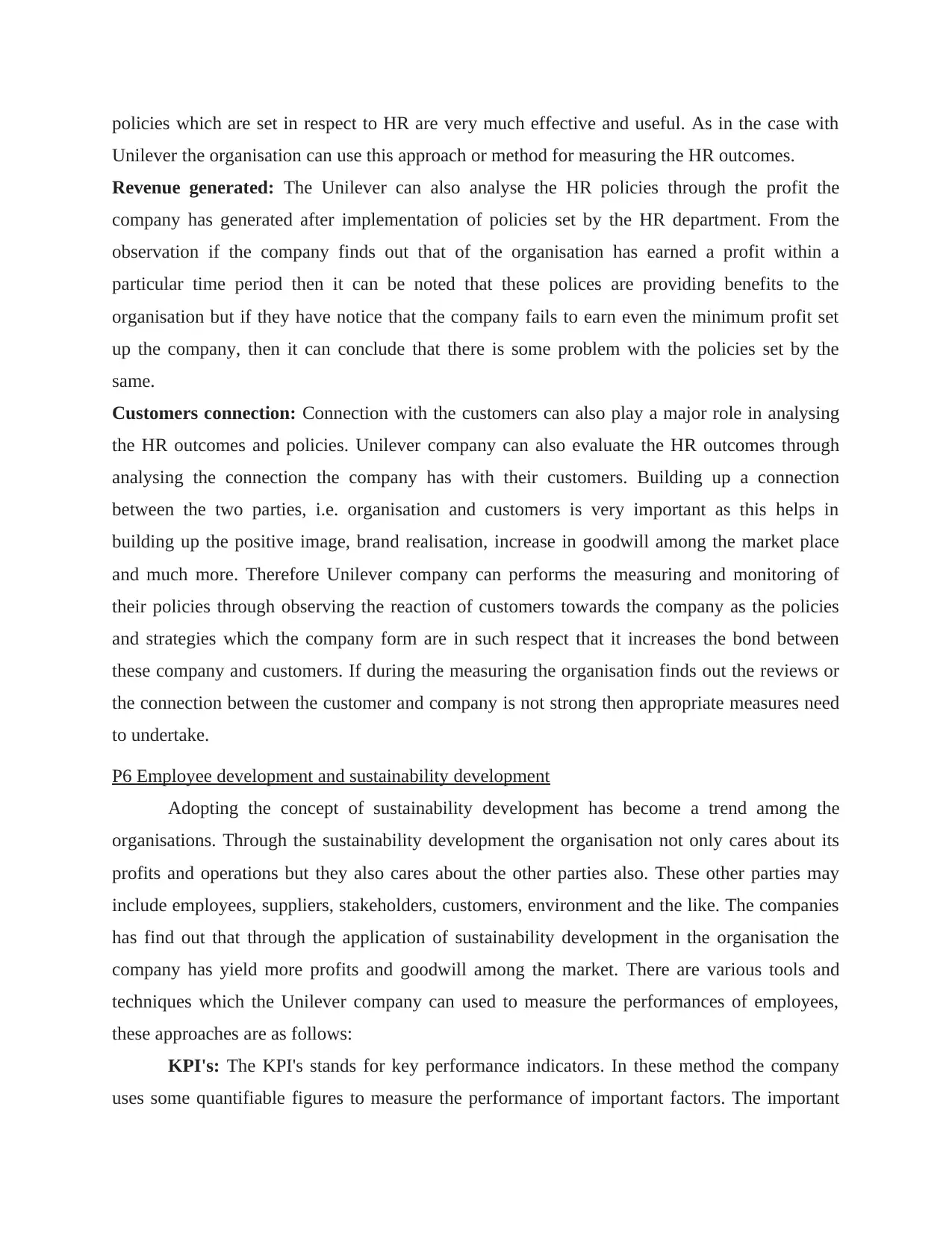
policies which are set in respect to HR are very much effective and useful. As in the case with
Unilever the organisation can use this approach or method for measuring the HR outcomes.
Revenue generated: The Unilever can also analyse the HR policies through the profit the
company has generated after implementation of policies set by the HR department. From the
observation if the company finds out that of the organisation has earned a profit within a
particular time period then it can be noted that these polices are providing benefits to the
organisation but if they have notice that the company fails to earn even the minimum profit set
up the company, then it can conclude that there is some problem with the policies set by the
same.
Customers connection: Connection with the customers can also play a major role in analysing
the HR outcomes and policies. Unilever company can also evaluate the HR outcomes through
analysing the connection the company has with their customers. Building up a connection
between the two parties, i.e. organisation and customers is very important as this helps in
building up the positive image, brand realisation, increase in goodwill among the market place
and much more. Therefore Unilever company can performs the measuring and monitoring of
their policies through observing the reaction of customers towards the company as the policies
and strategies which the company form are in such respect that it increases the bond between
these company and customers. If during the measuring the organisation finds out the reviews or
the connection between the customer and company is not strong then appropriate measures need
to undertake.
P6 Employee development and sustainability development
Adopting the concept of sustainability development has become a trend among the
organisations. Through the sustainability development the organisation not only cares about its
profits and operations but they also cares about the other parties also. These other parties may
include employees, suppliers, stakeholders, customers, environment and the like. The companies
has find out that through the application of sustainability development in the organisation the
company has yield more profits and goodwill among the market. There are various tools and
techniques which the Unilever company can used to measure the performances of employees,
these approaches are as follows:
KPI's: The KPI's stands for key performance indicators. In these method the company
uses some quantifiable figures to measure the performance of important factors. The important
Unilever the organisation can use this approach or method for measuring the HR outcomes.
Revenue generated: The Unilever can also analyse the HR policies through the profit the
company has generated after implementation of policies set by the HR department. From the
observation if the company finds out that of the organisation has earned a profit within a
particular time period then it can be noted that these polices are providing benefits to the
organisation but if they have notice that the company fails to earn even the minimum profit set
up the company, then it can conclude that there is some problem with the policies set by the
same.
Customers connection: Connection with the customers can also play a major role in analysing
the HR outcomes and policies. Unilever company can also evaluate the HR outcomes through
analysing the connection the company has with their customers. Building up a connection
between the two parties, i.e. organisation and customers is very important as this helps in
building up the positive image, brand realisation, increase in goodwill among the market place
and much more. Therefore Unilever company can performs the measuring and monitoring of
their policies through observing the reaction of customers towards the company as the policies
and strategies which the company form are in such respect that it increases the bond between
these company and customers. If during the measuring the organisation finds out the reviews or
the connection between the customer and company is not strong then appropriate measures need
to undertake.
P6 Employee development and sustainability development
Adopting the concept of sustainability development has become a trend among the
organisations. Through the sustainability development the organisation not only cares about its
profits and operations but they also cares about the other parties also. These other parties may
include employees, suppliers, stakeholders, customers, environment and the like. The companies
has find out that through the application of sustainability development in the organisation the
company has yield more profits and goodwill among the market. There are various tools and
techniques which the Unilever company can used to measure the performances of employees,
these approaches are as follows:
KPI's: The KPI's stands for key performance indicators. In these method the company
uses some quantifiable figures to measure the performance of important factors. The important
⊘ This is a preview!⊘
Do you want full access?
Subscribe today to unlock all pages.

Trusted by 1+ million students worldwide
1 out of 15
Related Documents
Your All-in-One AI-Powered Toolkit for Academic Success.
+13062052269
info@desklib.com
Available 24*7 on WhatsApp / Email
![[object Object]](/_next/static/media/star-bottom.7253800d.svg)
Unlock your academic potential
Copyright © 2020–2025 A2Z Services. All Rights Reserved. Developed and managed by ZUCOL.




